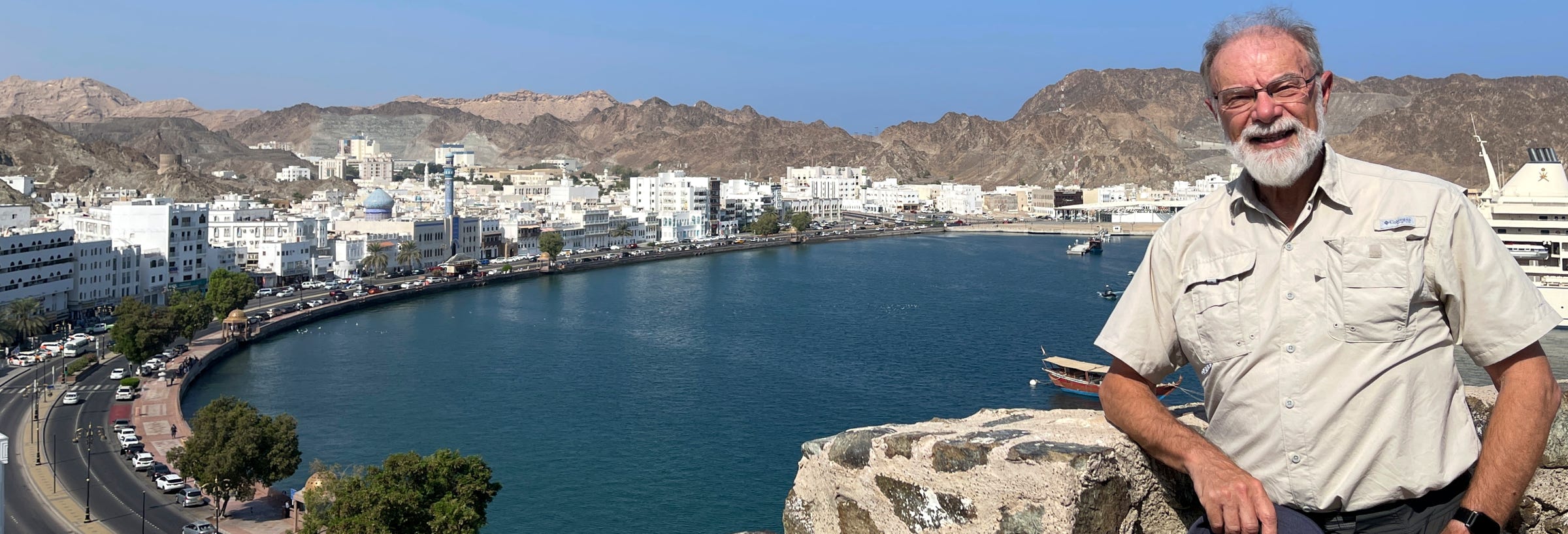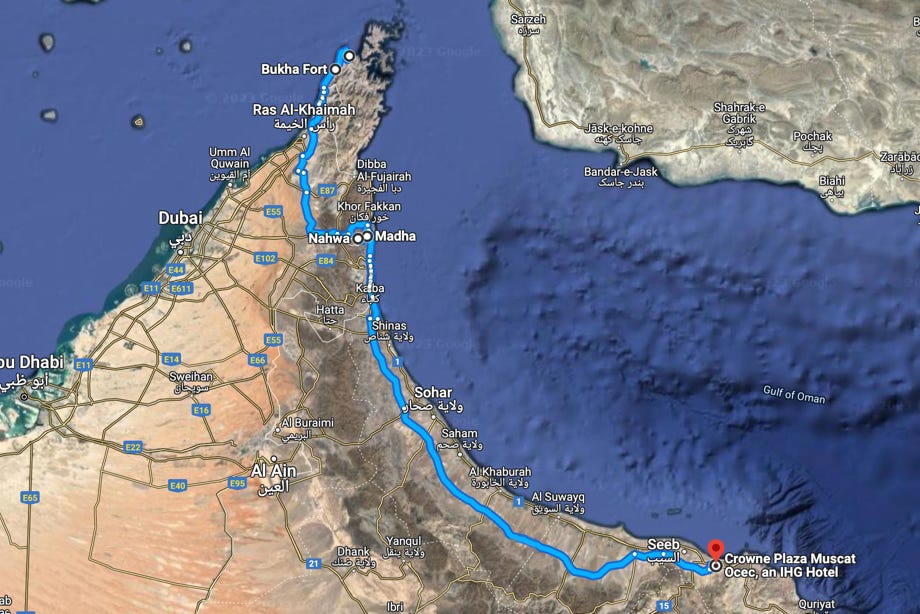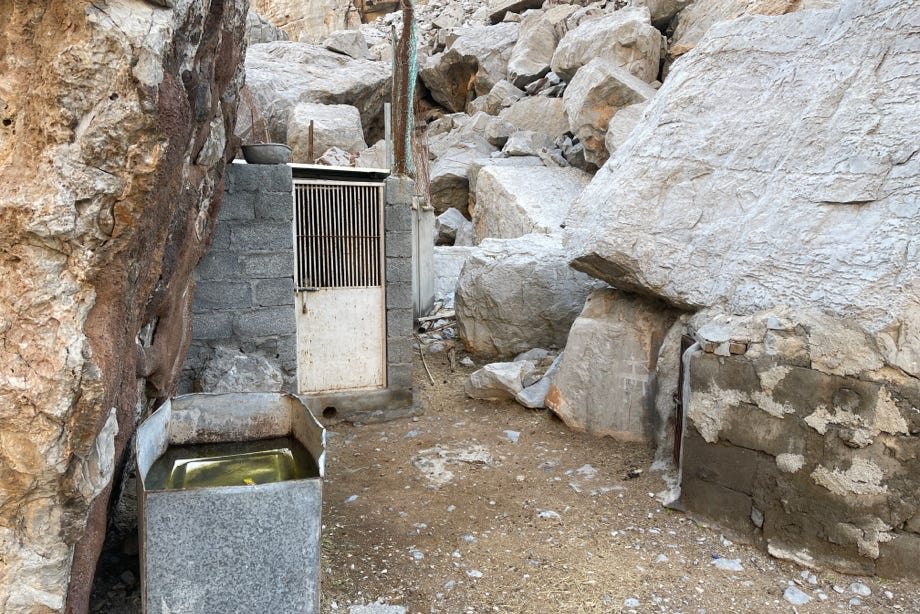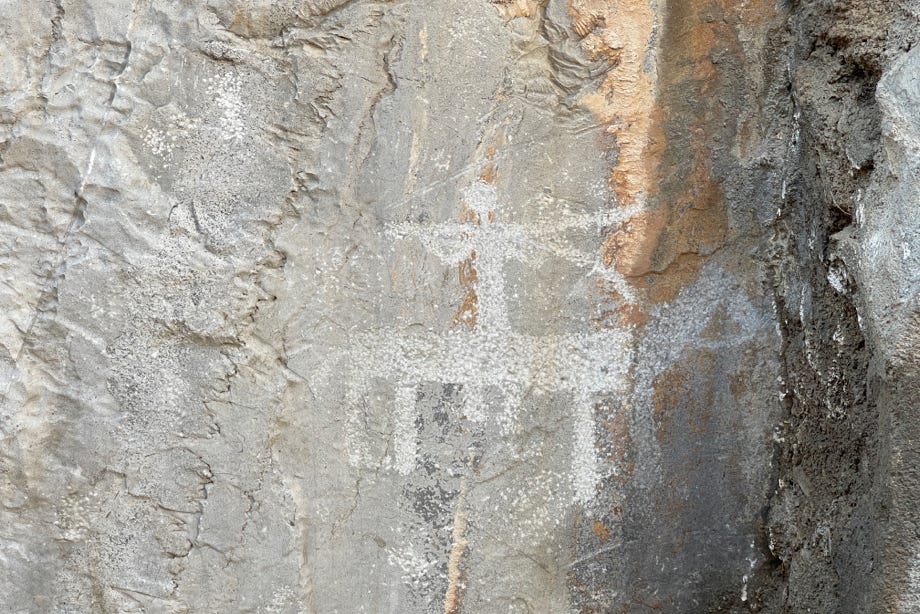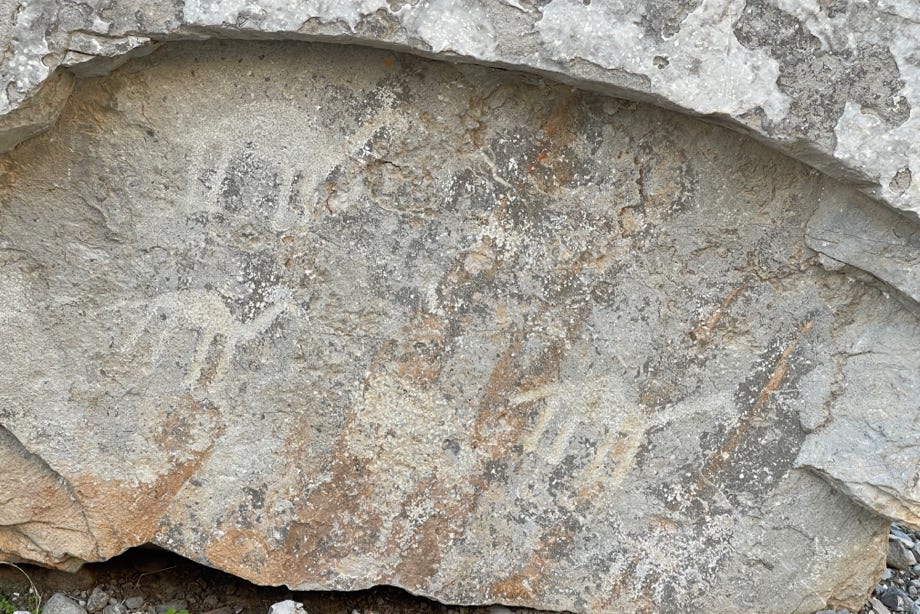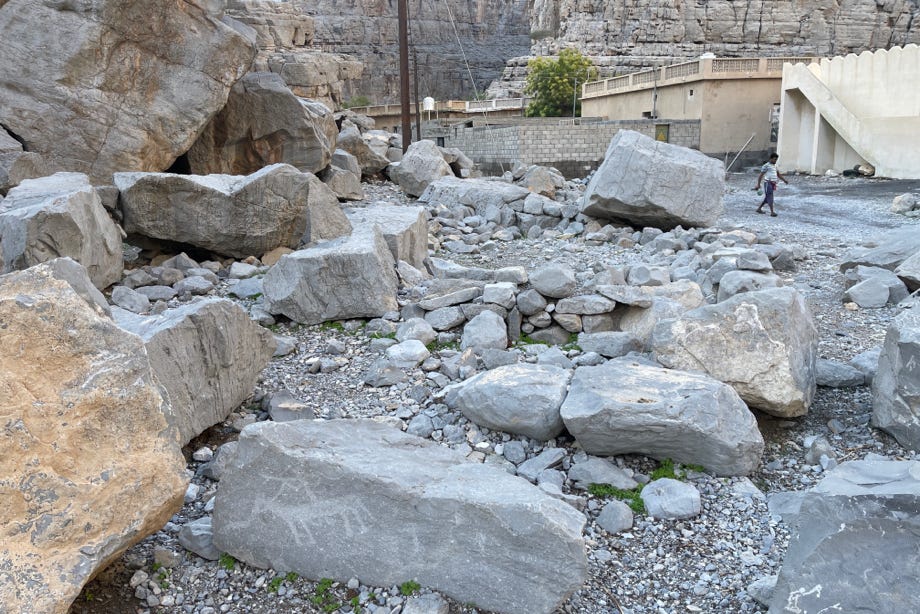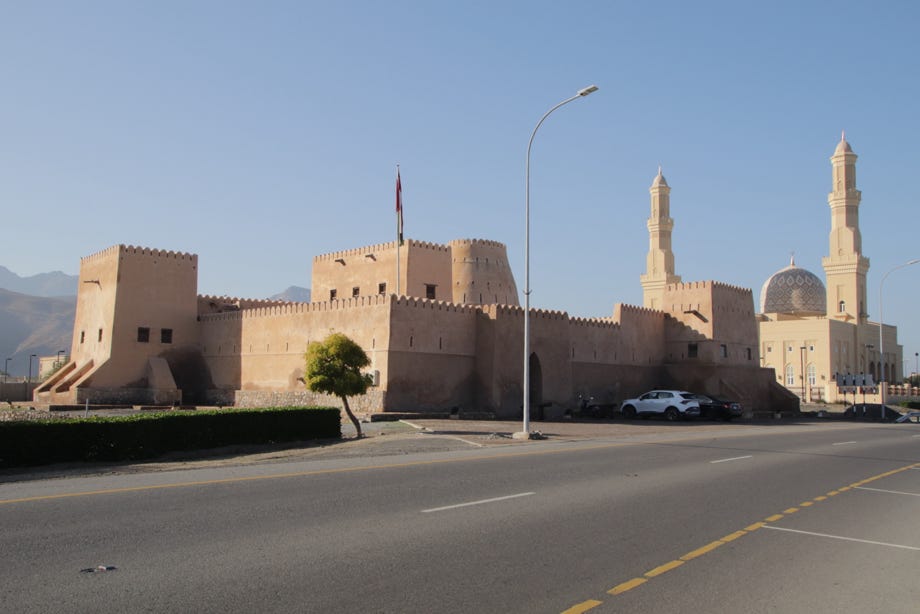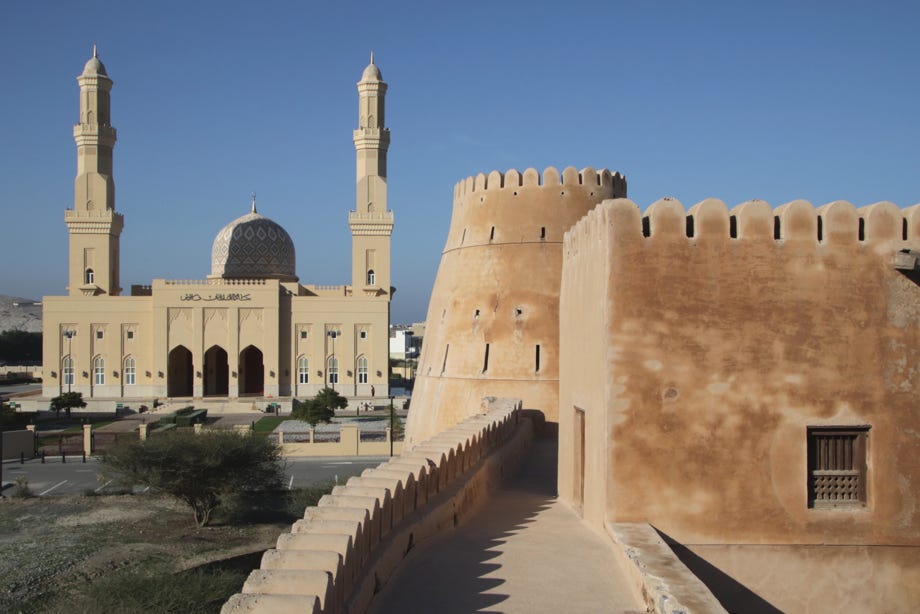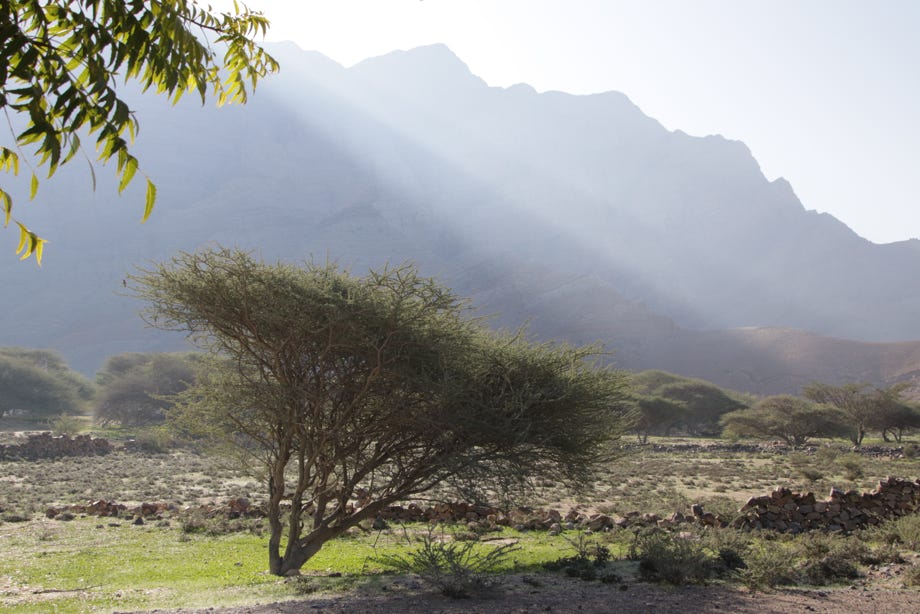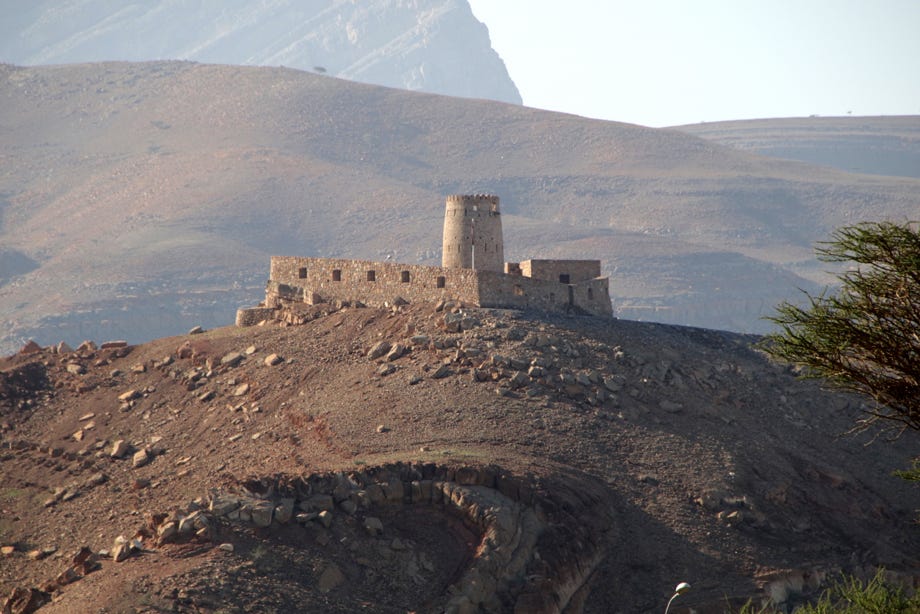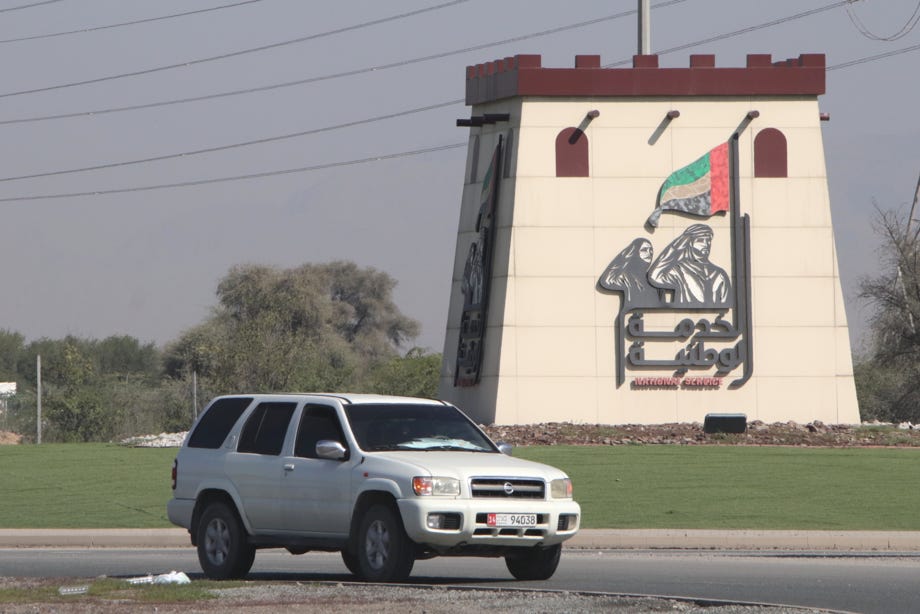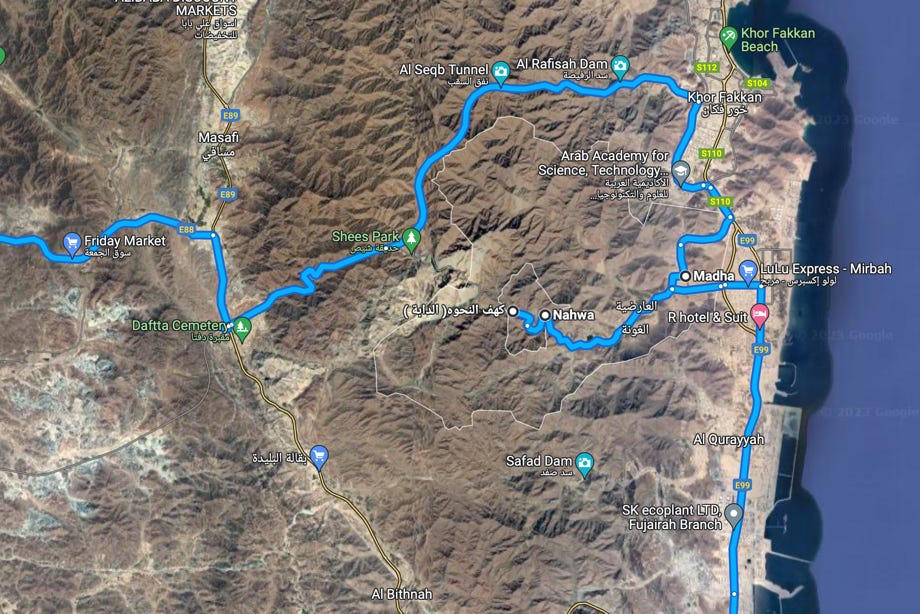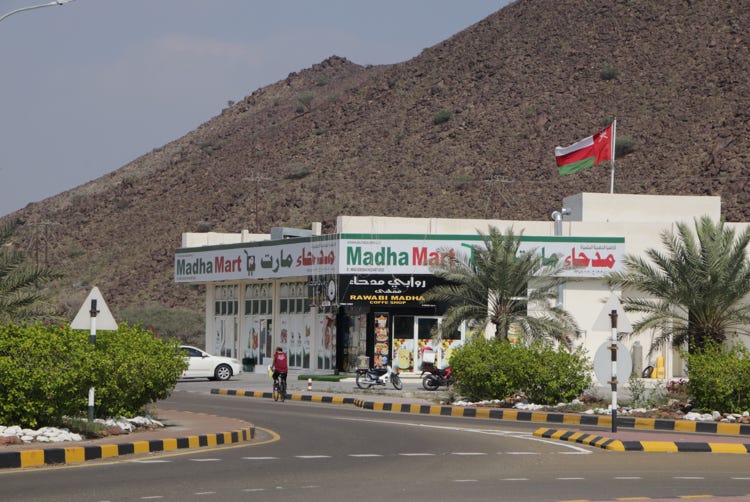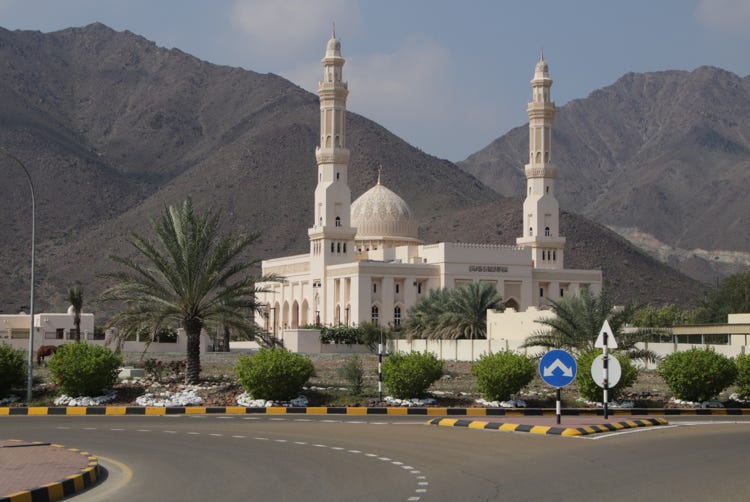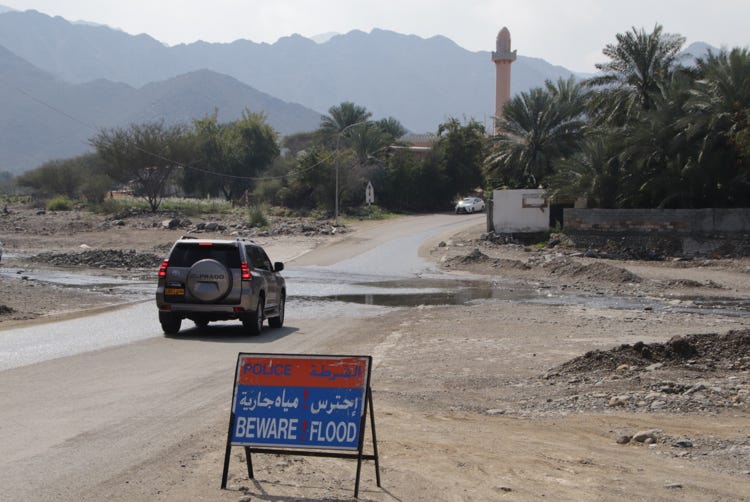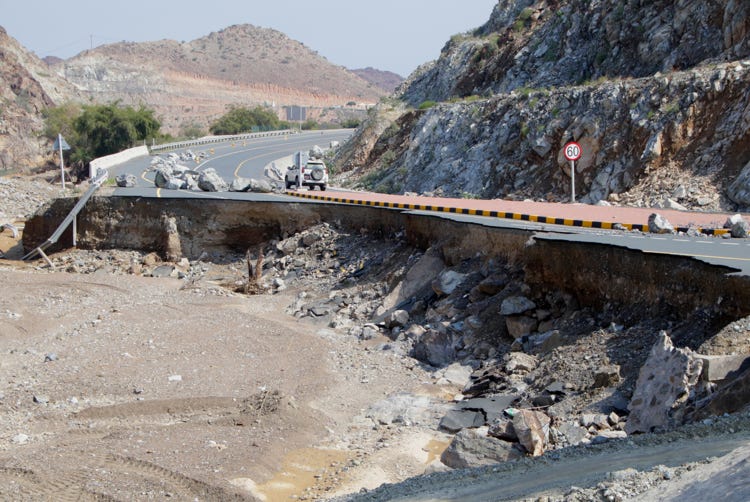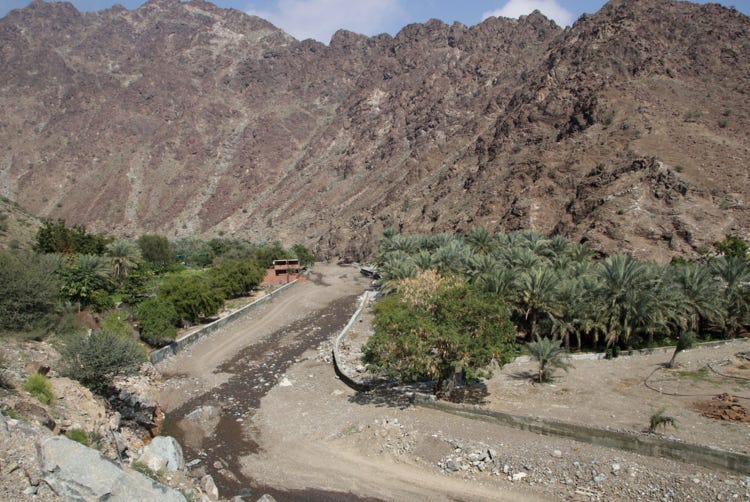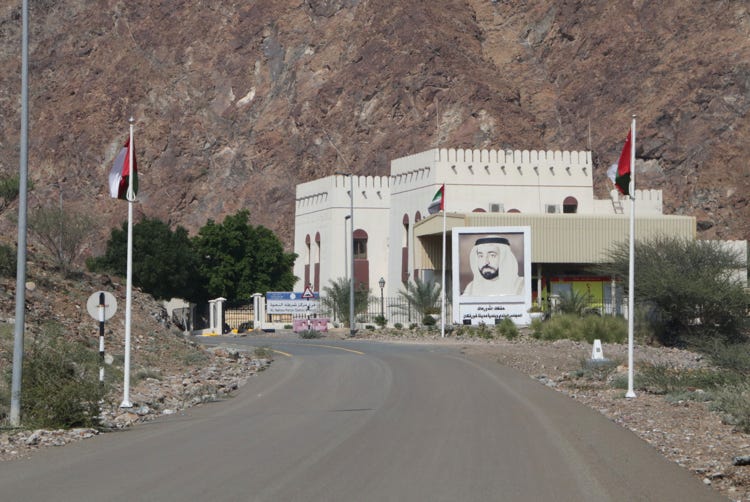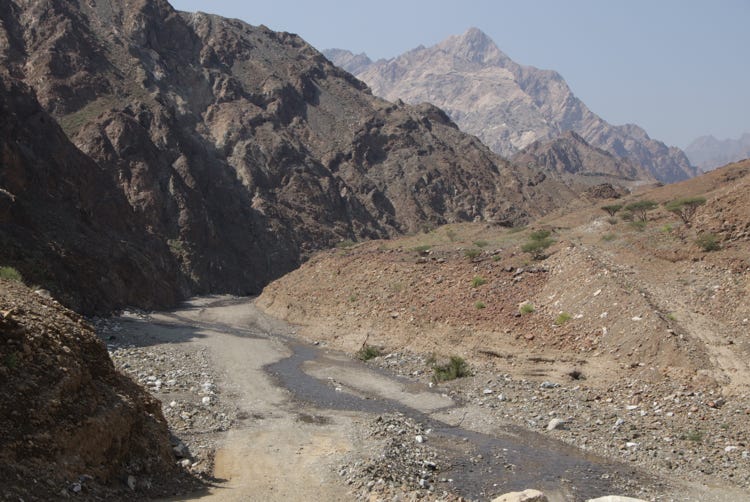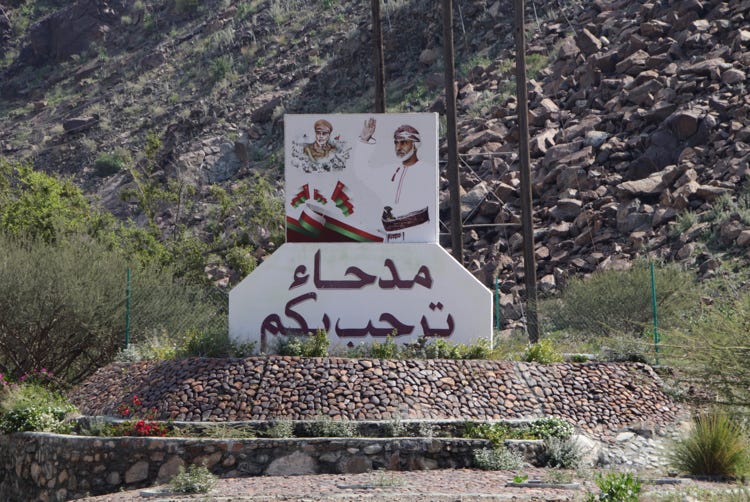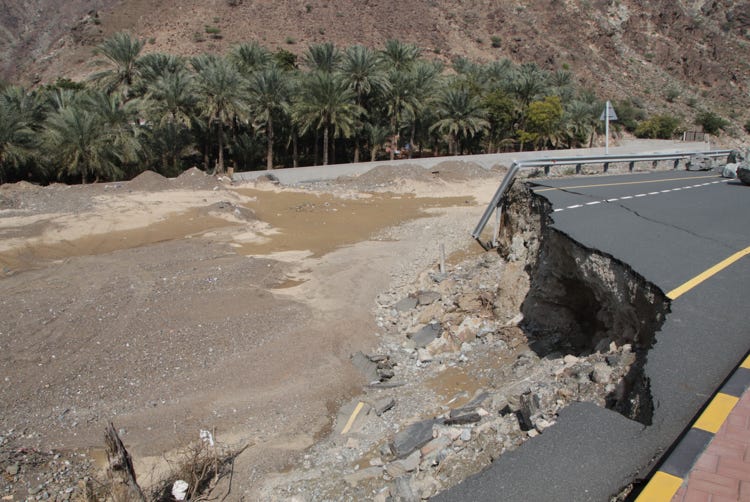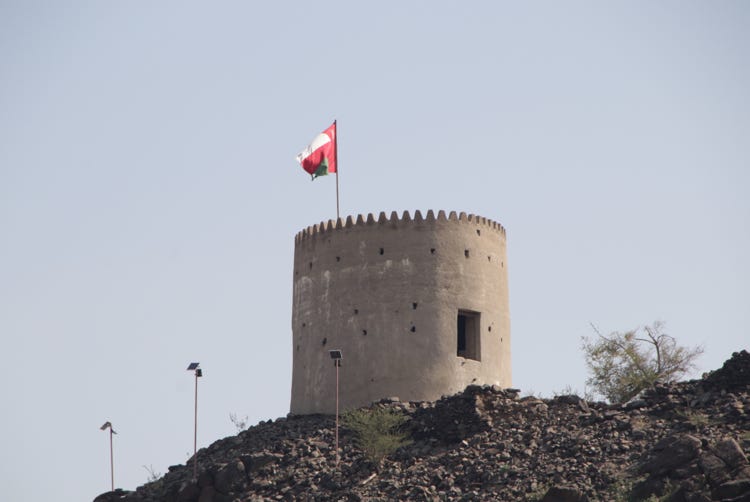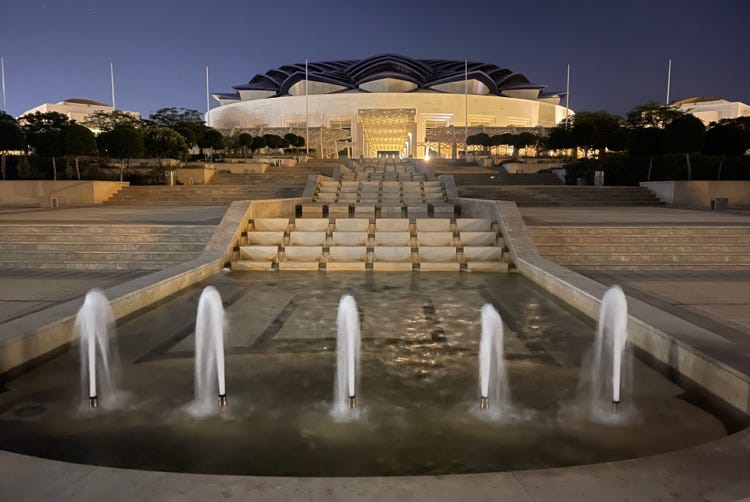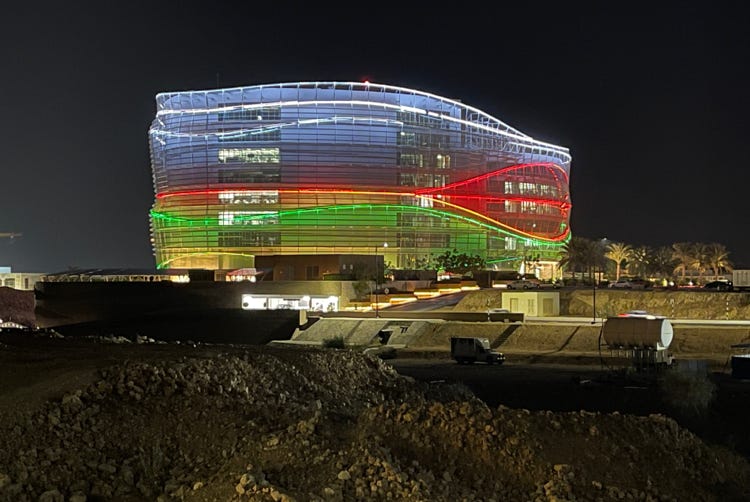Everyone knows the famous saying “what goes up must come down”. I had “gone up” (travelled north) from Muscat to Musandam, and today was the day to make the return trip. Long drives mean early starts, so I set my alarm for 6:00am, had breakfast as soon as the restaurant at the hotel opened, and I was on the road by 8:10am.
My first stop was just five and a half kilometres from my hotel. I had noticed on “Google Maps” that just south of Qadah, which is just south of Qida Beach where I had walked yesterday afternoon, ancient rock carvings were apparently visible beside the road. I headed to the place on the map, knowing that there would be no signage. All I could see were some loose boulders that seemed to have fallen down from the nearby cliffs and some small yards for goats. I was about to give up and then I saw the first carving – a light grey surface etching on a mid-grey rock, totally exposed to the elements, showing (I think) a person riding a horse while carrying long spears. It was on a boulder that was not only totally exposed to the elements, but right beside the door of a goat pen.
I looked at other rocks more closely and found a couple more – one showing a herd of camels (I think) and then a second horseback rider. I have idea how old these carvings are or who made them (nor, I suspect does anyone else), but if they are truly “ancient” then something needs to be done to protect them before they disappear, either by weathering or by passing goats.
My second stop was 25 kilometres further along the road to the UAE border. Bukha Fort was the destination I had thought about visiting yesterday afternoon when time ran short. I’m glad I didn’t make the 50 kilometre round trip to see it, but on the other hand, I am glad that I stopped along the way this morning.
Located beside a large mosque in the village of Bukha, the Fort was probably built in the late 1500s, and it was restored in 1990. There was no entry fee, and no displays (or information), but it was interesting to walk through and offered some good views of the surrounding area, including Al Qala's Fort, a watchtower on a nearby hill that overlooks Bukha Fort. Bukha Fort’s structure was fairly simple and appropriate for its small size, comprising a rectangular courtyard with one round corner tower, two rectangular corner towers and one central rectangular tower.
When Bukha Fort was built, it had a moat with an open connection to the sea. It is said that prisoners were chained to the walls of the moat to drown as the tide rose. Nowadays, the castle is separated from the sea by the coastal road that connects Khasab to the UAE border station near Tibat.
My next stop was an enforced one, being the border crossing. The border was very quiet and relaxed this morning with only two other people passing through when I was there. I arrived at the border at 9:40am, and had cleared immigration and customs on both the Omaini and Emirati sides by 10:10am.
Both sides of this border crossing require drivers (and their passengers) to park their cars and go into a small processing office. I immediately saw a possible problem with this – my Omani phone signal with Ooredoo that I relied upon for Google Maps navigation was going to be blocked and would not be accessible when I started my car again on the UAE side of the border. That was a problem as I had no paper map, and Emirati road signs are, shall we say, erratic. Furthermore I wasn’t just following major highways; my route took me along roads that would not be signposted either with my destination or with names I could locate without a map. When the chaos of Emirati driving was added to the equation, I was quite concerned.
Sure enough, when I started my car having cleared UAE Customs, all the directions I had entered into my phone had disappeared as my phone had connected automatically to a different network (Etisalat). I decided to try and retrieve my Ooredoo signal by manually selecting it, and this almost worked; I was able to connect but not for calls or data – it was simply an “E” for ‘emergency’ link.
I drove a couple of circles around the car park in the border post trying to fool the phone into thinking I might still be in Oman – and it worked (just). Still displaying “E”, I was able to get just enough connection to recognise my routing and load the base maps. With a huge sigh of relief that I didn’t need to go searching for a local SIM card in the border town of Al Jeer, I headed off with the confidence that my phone now knew the way, even if I didn’t.
Apart from stops to cross borders and buy fuel, I had only one other destination on my way back to Muscat. Those who know me understand that I love geographical quirkiness, and today I visited one lovely geographical quirk. Roughly half way between the Musandam Peninsula of Oman and the Omani “mainland” lies Madha, a tiny Omani enclave that is surrounded by the UAE near the city of Khor Fakkan.
The enclave of Madha has an area of just 75 square kilometres and a population of about 2,500 people. There is quite some history to explain why Madha is Omani rather than Emirati land (see https://en.wikipedia.org/wiki/Madha), but essentially the local people chose to align themselves with the Omani sultan rather than the local emirs or sheikhs. There is no border post into or out of Madha.
However, the quirkiness reaches another level. Madha is essentially a doughnut-shaped enclave because within it lies a UAE enclave named Nahwa. With a total area of 4.4 square kilometres and a population of about 300, Nahwa is therefore a second order enclave. Needless to say, second order enclaves are very rare (https://en.wikipedia.org/wiki/Nahwa), so I thought a visit there would also be worthwhile.
My initial impression upon entering Madha was that it was extraordinarily unremarkable, and certainly several steps down from the extravagant buildings that the Emiratis had constructed nearly on its border in Khor Fakkan. Having said that, it was great to be back in Ooredoo’s territory to refresh my mapping once again. There was a large mosque with some horses grazing on some vacant land across the road, a supermarket and some blocks of housing. For “normal” mortal people (i.e. people who are aren’t geographers), Madha would be an unlikely destination.
I decided to press on westwards and see what Narwa was like. Between the two towns there was a spectacular washout which had destroyed much of the roadway and bridge; that alone was enough to my visit to Madha worthwhile.
There wasn’t much to see in Narwa. The main town, which was right on the Omani border, comprised little more than a huge police station, a school, a few small shops, and another destroyed bridge. I continued westward, and the road deteriorated markedly. Shortly before I reached the inner ring of the Omani border on the western side of Narwa, the road and the gravel bed of a wadi became one and the same thing. As the gravel was slippery and unconsolidated – the water was flowing today – I thought better of continuing any further, so I turned around and headed back.
It took only a few minutes to cross from the western to the eastern edge of Narwa and I was back in Madha. A few minutes after that I was back in the UAE and continuing my drive south to the Omani border.
I reached the border at 2:00pm. As was the case leaving Musandam this morning, very few people were crossing the border in either direction at Khatmat Milaha this afternoon, and I was back in Oman and on my way to Muscat by 2:30pm.
Once on the freeway, it was a quick drive to my hotel near Muscat Airport – 318 kilometres at a fairly constant 120 kilometres per hour, arriving at 5:25pm after a stop for fuel.
Having done very little walking today because of the long drive, I checked into my room and then went for a three kilometre walk in the area around the hotel. The hotel (the Crowne Plaza OCEC) is situated very close to the Omani Convention and Exhibition Centre, and I chose it because of its location near the airport as I have an early flight on Thursday morning. The area is a newly developing zone of Muscat which lacks the ambience of the site of my previous hotel in Muscat which overlooked the ocean. Nonetheless, it was good to walk the streets and get some air in my lungs after the long drive.
